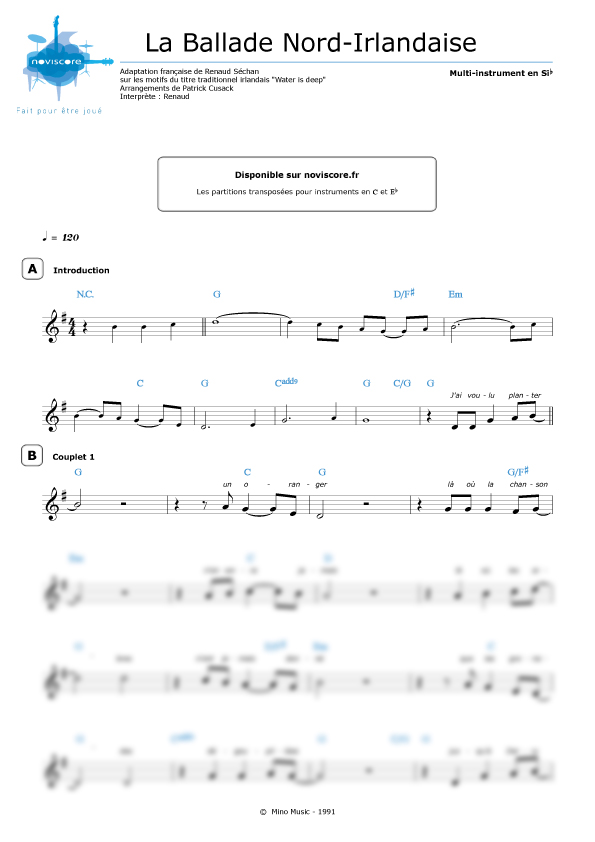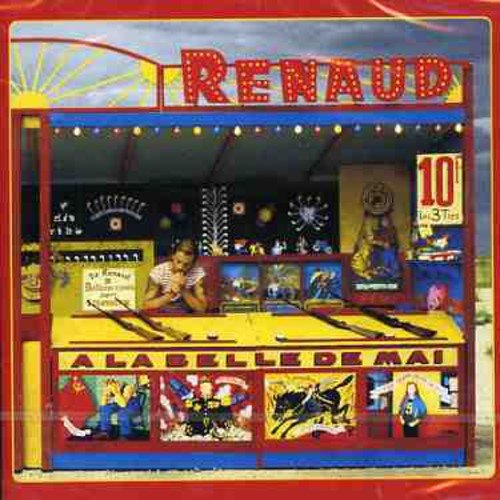Paroles De Renaud La Ballade Nord-Irlandaise: A Deep Dive Into The Lyrics And Their Meaning
**Ever wondered what makes "La Ballade Nord-Irlandaise" such a timeless masterpiece? This iconic song by Renaud has captivated audiences worldwide, resonating with listeners of all ages. It’s not just a song—it’s an anthem of rebellion, love, and struggle. Today, we’re diving deep into its lyrics, uncovering hidden meanings, and exploring why this track continues to inspire so many people around the globe. So grab your coffee, get comfy, and let’s unravel the magic behind this legendary ballad.**
When it comes to French music, few artists hold a candle to Renaud. His work is raw, emotional, and deeply rooted in social activism. "La Ballade Nord-Irlandaise" stands out as one of his most celebrated songs, blending poetic lyrics with powerful storytelling. But what exactly makes this song so special? Let’s find out.
This article isn’t just about dissecting the lyrics—it’s about understanding the man behind them. From Renaud’s early life to his artistic evolution, we’ll explore how his experiences shaped the creation of this unforgettable piece. By the end, you’ll have a newfound appreciation for both the artist and the song.
Who Is Renaud? A Brief Biography
Renaud Séchan, better known simply as Renaud, is more than just a musician—he’s a cultural icon. Born on May 11, 1952, in Boulogne-Billancourt, France, Renaud grew up in a family of artists and writers. His father, Maurice Séchan, was a respected poet, and his mother, Marguerite Souplex, was a novelist. This artistic upbringing played a crucial role in shaping Renaud’s unique voice and style.
Before diving into his music career, Renaud worked as a teacher and even pursued acting. However, it was his passion for songwriting that eventually took center stage. With his first album, "Amoureux de Paname," released in 1979, Renaud quickly became a household name in France. Known for his rebellious spirit and socially conscious lyrics, he carved out a niche for himself in the music industry.
Key Facts About Renaud
Here’s a quick glance at some key facts about Renaud:
- Birthdate: May 11, 1952
- Birthplace: Boulogne-Billancourt, France
- Occupation: Singer, songwriter, actor
- Genre: Chanson, Rock, Folk
- First Album: "Amoureux de Paname" (1979)
Understanding "La Ballade Nord-Irlandaise"
Released in 1980 as part of the album "Mistral Gagnant," "La Ballade Nord-Irlandaise" quickly became one of Renaud’s most iconic tracks. The song tells the story of a young Irish rebel named Frankie Armstrong, who fights for freedom against British oppression. Through vivid imagery and evocative lyrics, Renaud paints a picture of love, loss, and resistance.
But why did Renaud choose Northern Ireland as the backdrop for this song? At the time, the conflict between Catholics and Protestants in Northern Ireland—commonly referred to as "The Troubles"—was at its peak. Inspired by the struggles of the Irish Republican Army (IRA), Renaud crafted a narrative that resonated with anyone fighting for justice and equality.
Breaking Down the Lyrics
Let’s take a closer look at some of the most memorable lines from the song:
- "Frankie Armstrong, il avait dix-sept ans, quand il est mort pour l'Irlande" – This opening line introduces us to Frankie Armstrong, a young man who gave his life for the cause of Irish independence.
- "Elle s'appelait Mary, elle était belle comme l'été" – Here, we meet Mary, Frankie’s love interest, whose beauty and presence symbolize hope and resilience.
- "Et les Anglais sont venus, avec leurs bottes et leurs chars" – This line highlights the oppressive nature of British rule in Northern Ireland, setting the stage for Frankie’s ultimate sacrifice.
Themes and Symbolism in the Song
At its core, "La Ballade Nord-Irlandaise" is a song about resistance and solidarity. It explores themes of love, loss, and the fight for freedom. But beyond the surface-level narrative, there are deeper layers of symbolism that make this song so compelling.
For instance, Frankie Armstrong represents the countless young people who have lost their lives in the pursuit of justice. Mary, on the other hand, symbolizes the hope and beauty that can emerge even in the darkest of times. Together, these characters create a powerful metaphor for the human spirit’s ability to endure and overcome adversity.
Historical Context
Understanding the historical context of "The Troubles" is essential to fully appreciating the song’s message. Between the late 1960s and the late 1990s, Northern Ireland was embroiled in a violent conflict between Catholics (who wanted a united Ireland) and Protestants (who wanted to remain part of the United Kingdom). This conflict resulted in thousands of deaths and left deep scars on the region’s social and political landscape.
Renaud’s decision to address this issue through his music was both brave and timely. By shedding light on the struggles of the Irish people, he brought attention to a cause that many outside of Northern Ireland might not have been aware of.
Why Does This Song Resonate With Listeners?
The enduring popularity of "La Ballade Nord-Irlandaise" can be attributed to several factors. First and foremost, Renaud’s ability to tell a compelling story through his lyrics sets him apart from other artists. His use of vivid imagery and emotional language creates a connection with listeners that transcends language barriers.
Additionally, the song’s universal themes of love and resistance make it relatable to audiences across cultures and generations. Whether you’re fighting for independence, equality, or simply trying to make sense of the world around you, there’s something in this song that speaks to everyone.
Impact on Popular Culture
Since its release, "La Ballade Nord-Irlandaise" has had a significant impact on popular culture. It has been covered by numerous artists, referenced in films and TV shows, and even used in political protests. Its influence extends far beyond the music world, making it a cultural touchstone for millions of people worldwide.
Behind the Scenes: How the Song Was Created
According to Renaud himself, the inspiration for "La Ballade Nord-Irlandaise" came from a combination of sources. He was deeply moved by the struggles of the Irish people and wanted to create something that would honor their fight. At the same time, he was influenced by traditional Irish folk music, which can be heard in the song’s melody and arrangement.
Writing the lyrics was a labor of love for Renaud. He spent countless hours crafting each line, ensuring that the story he wanted to tell was both authentic and impactful. The result is a masterpiece that continues to inspire and move people decades after its release.
Collaborations and Influences
Renaud didn’t work alone on "La Ballade Nord-Irlandaise." He collaborated with several talented musicians and producers to bring the song to life. Their combined efforts helped create a sound that was both innovative and timeless.
In addition to his musical collaborators, Renaud drew inspiration from a wide range of sources, including literature, poetry, and cinema. These influences are evident in the song’s rich narrative and poetic language.
Legacy and Influence
Today, "La Ballade Nord-Irlandaise" is considered one of Renaud’s greatest achievements. It has been covered by countless artists, translated into multiple languages, and performed at concerts around the world. Its legacy extends far beyond the music industry, making it a cultural phenomenon that continues to inspire new generations of listeners.
But what does the future hold for this iconic song? As long as people continue to fight for justice and equality, "La Ballade Nord-Irlandaise" will remain relevant and powerful. Its message of hope and resistance is timeless, ensuring its place in the annals of musical history.
Modern Reinterpretations
In recent years, several artists have reinterpreted "La Ballade Nord-Irlandaise" for modern audiences. These reinterpretations often incorporate elements of hip-hop, electronic music, and other genres, giving the song a fresh and contemporary feel. While the original version will always hold a special place in fans’ hearts, these modern takes help introduce the song to new listeners and keep its legacy alive.
Conclusion: Why "La Ballade Nord-Irlandaise" Matters
In conclusion, "La Ballade Nord-Irlandaise" is more than just a song—it’s a cultural touchstone that speaks to the human experience. Through its powerful lyrics and evocative storytelling, it captures the essence of love, loss, and resistance in a way that resonates with listeners across cultures and generations.
So the next time you hear this song, take a moment to reflect on its deeper meaning. Think about the struggles of the Irish people, the sacrifices of Frankie Armstrong, and the enduring power of hope. And if you’re moved by what you’ve learned, why not share this article with a friend? Let’s keep the conversation going and ensure that Renaud’s legacy lives on for years to come.
Table of Contents
Who Is Renaud? A Brief Biography
Understanding "La Ballade Nord-Irlandaise"
Themes and Symbolism in the Song
Why Does This Song Resonate With Listeners?
Behind the Scenes: How the Song Was Created
Conclusion: Why "La Ballade Nord-Irlandaise" Matters

Other sheet music La Ballade NordIrlandaise (Renaud) easy sheet

Bouzouki GDAE La Ballade NordIrlandaise

Tablature La ballade nord irlandaise de Renaud 2805227